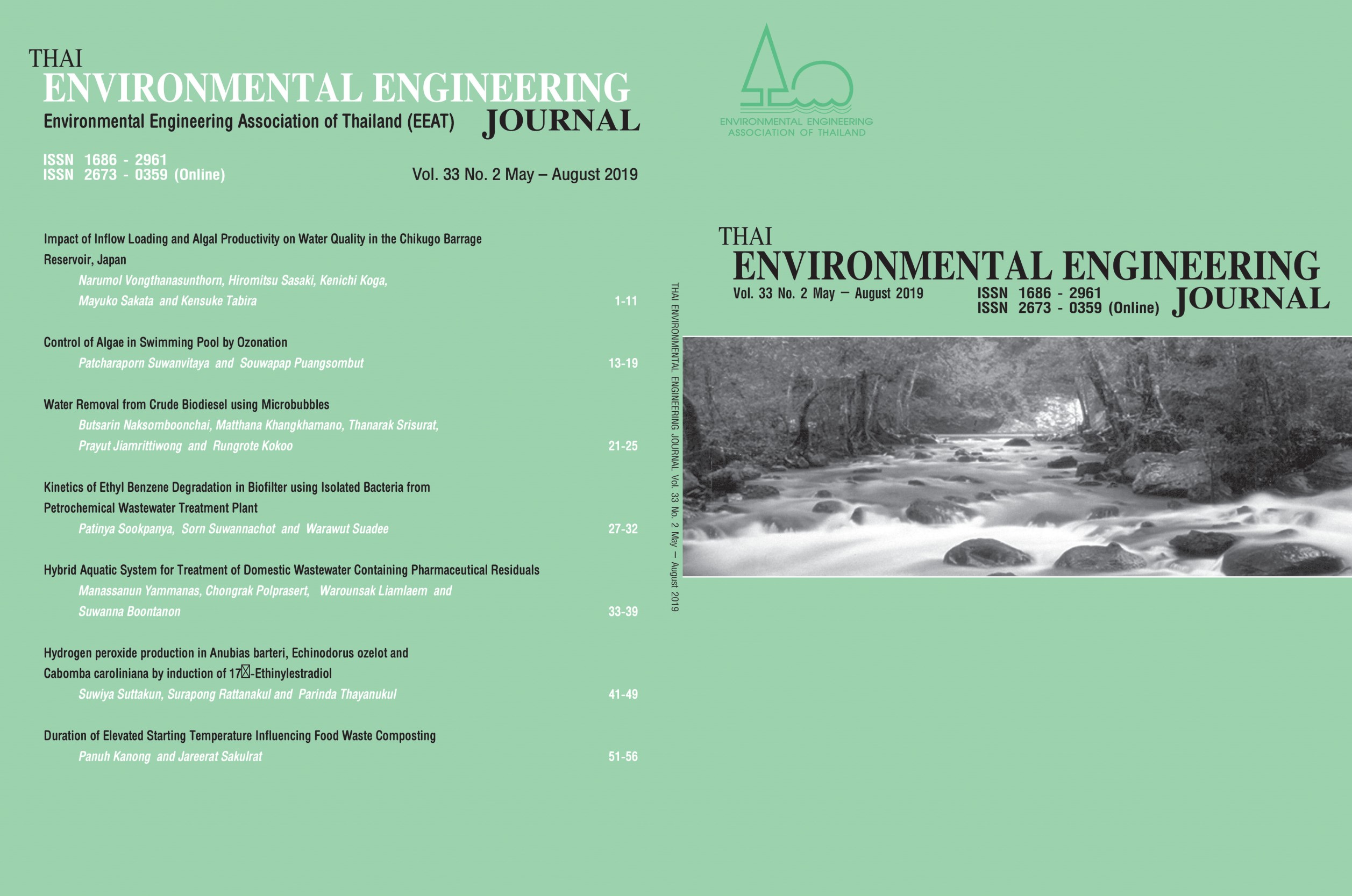Hydrogen peroxide production in Anubias barteri, Echinodorus ozelot and Cabomba caroliniana by induction of 17α-Ethinylestradiol
Main Article Content
Abstract
The 17α-ethinylestradiol (EE2), a synthetic estrogen has become public concern on the contamination in the aquatic environment because of its endocrine-disrupting properties which can cause adverse effects on aquatic organisms. EE2 is reported to be effectively removed by advanced wastewater treatment technologies; however, due to its high operating cost other low-cost technologies such as constructed wetland might be more suitable. Since certain plant species were reported to produce high endogenous hydrogen peroxide (H2O2) under stress condition including EE2 and enabled to induce hydroxyl radicals (•OH) when exposing to external dissolved iron through the Fenton-like reaction. This Phyto-Fenton process is possible to be combine in constructed wetland for 17α-ethinylestradiol (EE2) removal. In this study, aquatic commercial plants including Anubias (Anubias barteri), Amazon (Echinodorus ozelot), and Green Cabomba (Cabomba caroliniana) were introduced to the solution containing different EE2 concentrations as an environmental stressor to investigate H2O2 production. The results revealed the increasing of H2O2 production following the increase of EE2 concentration in Amazon, while Anubias and Green Cabomba showed no difference with the control. Based on morphological observation, Amazon branch still appeared healthy compared to other plants after exposing to EE2 for 21 days. The results suggested that Amazon was the most suitable aquatic commercial plants among all selected species in this study for applying to remove EE2 in constructed wetlands.
Article Details
References
[2] U.S. EPA. 2000. Manual Constructed Wetlands for Municipal Wastewater Treatment. Ohio: United States Environmental Protection Agency.
[3] Muller, M., Patureau, D., Godon, J.J., Delgénes, J.P. and Raquet, G.H. 2010. Molecular and kinetic characterization of mixed cultures degrading natural and synthetic estrogens. Appl Microbiol Biotechnol 85, 691–701
[4] Duong, C.N., Ra, J.S., Cho, J., Kim, S.D., Choi, H.K., Park, J.H., Kim, K.W., Inam, E. and Kim, S.D. 2010. Estrogenic chemicals and estrogenicity in river waters of South Korea and seven Asian countries. Chemosphere 78, 286–293.
[5] Jain, B., Singh, A.K, Kim, H., Lichtfouse, E. and Sharma, V.K. 2018. Treatment of organic pollutants by homogeneous and heterogeneous Fenton reaction processes. Environmental Chemistry Letters 16(3), 947-67.
[6] Wang, S. 2008. A Comparative study of Fenton and Fenton-like reaction kinetics in decolourisation of wastewater. Dyes and Pigments 76(3), 714-20.
[7] Inagakia, Y., Cong, V.H. and Sakakibara, Y. 2016. Identification and application of Phyto-Fenton reactions. Chemosphere 144, 1443–1450.
[8] Jain, B., Singh, A.K., Kim, H., Lichtfouse, E. and Sharma, V,K. 2018. Treatment of organic pollutants by homogeneous and heterogeneous Fenton reaction processes. Environmental Chemistry Letters 16(3), 947-67.
[9] Gan, S., Amasino, R.M. 1997. Making sense of senescence (molecular genetic regulation and manipulation of leaf senescence). Plant. Physiol 113, 313–319.
[10] Río, L.A.D., Pastori, G.M., Palma, J.M., Sandalio, L.M., Sevilla, F., Corpas, F.J., Jiménez, A., López-Huertas, E. and Hernández, J.A. 1998. The activated oxygen role of peroxisomes in senescence. Plant Physiol 116, 1195–1200.
[11] Zhou, B., Wang, J., Guo, Z., Tan, H. and Zhu, X. 2006. A simple colorimetric method for determination of hydrogen peroxide in plant tissues. Plant Growth Regul 49, 113-118.
[12] Jajic, I., Sarna, T. and Strzalka, K. 2015. Senescence, Stress, and Reactive Oxygen Species. Plants 2015(4), 393-411.
[13] Koottatep, T., Chapagain, S.K., Phong, V.H.N., Panuvatvanich, A., Ahn, K.H. and Polprasert C. 2016. Performance Evaluation of Selected Plants and Iron Rich Media for Removal of PPCPs from Wastewater in Constructed Wetlands. Conference Paper.
[14] Velikova, V., Yordanov , I. and Edreva, A. 2000. Oxidative stress and some antioxidant system in acid rain treated bean plants: protective role of exogenous polyammines. Plant Sci 151, 59–6


